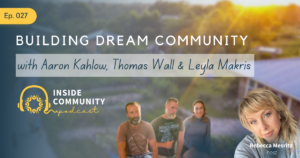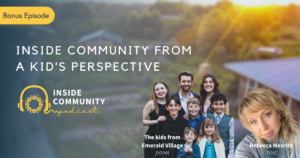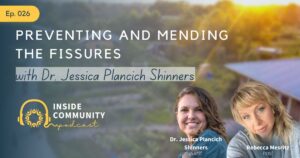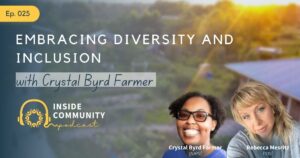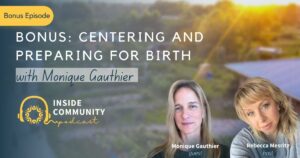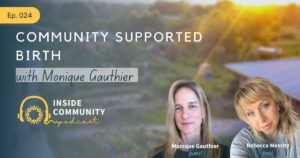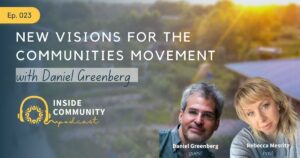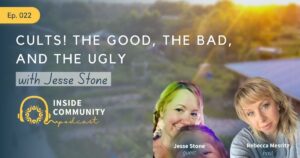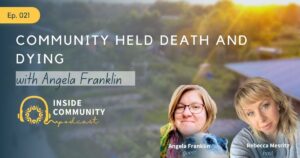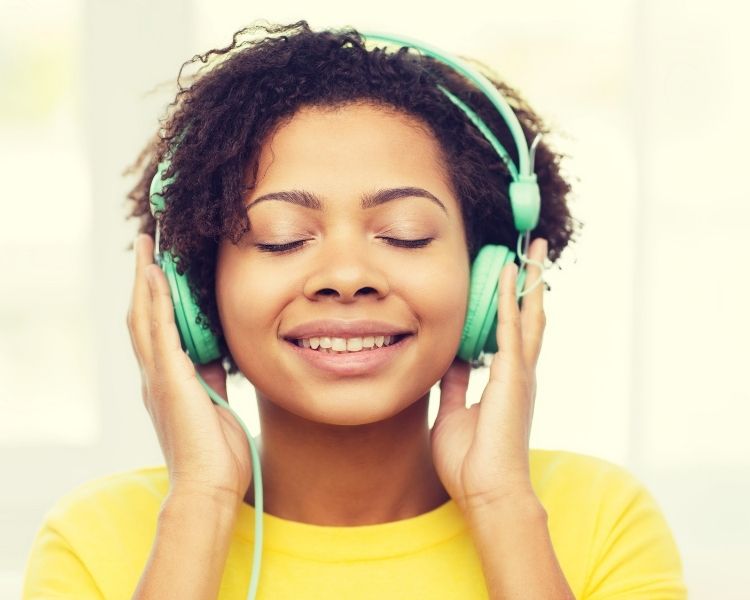Why me? Why now? The Introduction
Inside Community Podcast — Ep. 000
In this episode, I take a moment to introduce myself, tell you a little bit about my journey creating and living in community, and why this podcast felt so important for me to create now.
Follow the show and see inspiring images and video of community life on Instagram @InsideCommunityPodcast – I’d love to hear from you there! If this content has been meaningful or useful to you, please subscribe, rate and review on Apple Podcasts, and share with your friends and folks you know who are curious about living Inside Community. Your financial support of Inside Community helps us to continue to create meaningful and exciting content and I hope you’ll consider donating.
— Rebecca, your podcast host
Espisode Transcript
0:04
Hey friends, welcome back to the inside community podcast where I bring you along for an inside look at all of the beautiful and messy realities of creating and sustaining a community. I hope you’ve had a chance to listen to my first episode where I talk about what I mean by intentional community, and where I break down some of the fantasies and realities of what community is. But if you are new to this topic, an intentional community is a group of people who have chosen to live together or share resources on the basis of common values. Before we get too deep into this first season, I want to take a moment to introduce myself and tell you a little bit about my experience with community and why this podcast felt so important for me to create right now. My name is Rebecca Mesritz. And I’ve been living in intentional community for over a decade, and researching visiting and learning about the communities movement for about 20 years. I am a white mother in my early 40s. I grew up in Baltimore, the daughter of college educated, working class parents, I’m socialized in presenting as female, I experienced myself as bisexual, and I’m married to a cisgender male. When I started exploring this world, I was in my 20s, going to college in San Francisco, and started to meet people who were choosing alternative living situations that were different from the typical roommate realities I previously observed. I was intrigued by the innovative ways of sharing space, food and general resources. During this time, I also began to find myself immersed in the transformational festival scene. For those of you who don’t know what that means, you may have heard of Burning Man, which is probably the epitome of that reality. These alternative living situations, were by no coincidence, highly influenced by burning man as well. And to be honest, that culture had a profound impact on my personal worldview. As it emphasized values I still hold today, ideals like radical self expression, personal responsibility, communal effort, and leave no trace. In 2005, I moved to San Diego, California to pursue a master’s degree in fine art, and build a career as an artist mainly in metal and wood, building furniture, large scale sculpture, and ornamental metalwork, but also in performance art, with a focus on ritual and spirituality as my inspirations. still active in the festival scene. I found myself one fortuitous weekend at a small Burning Man style event in Mexico. I had no idea that that event, that weekend would change the trajectory of my life, for it was there that I met the people who became my closest friends and collaborators. For several years, we would travel together far and wide to festivals, and build large camps, coordinate intricate ceremonies and beautiful interactive performances with elaborate stages, props and costumes. We’d work with musicians to compose gorgeous music for these productions, and then share sumptuous feasts and dance through the night. Then, at the end of the weekend, break the whole thing down and then home back to our quote unquote, normal lives. During this time, several in our group began working with the same spiritual teacher and doing some profound personal healing work, looking at moving through and releasing the anger, trauma, pain and grief of generations of life out of balance. It wasn’t long before we began to look at our lives and ask ourselves what’s next? We were having a lot of fun. But we wanted to build something that didn’t need to be taken down at the end of the weekend, something that would have a larger reaching positive impact on the world around us. And most importantly, something that felt not just sustainable, but actually regenerative that we could envision bringing children and future generations into. This was the beginning of the Emerald Village. After organizing our own mini festival that focused on topics of community building, and even a community survey asking folks things like, where would you want to live in relation to a city? Or what type of work would you want to contribute to a community and what type of housing would you need? A small core group comprised of five couples 10 People began to come together on a more regular basis. We started sharing holidays and weekly meals, all while still living in our own homes in three different cities. Then, two of the couples moved into a house together around the corner from another one of the couples. We started doing exercises from Diana leaf Christian’s book creating a life together.
4:55
We took classes on the holographic model, which was our early stab and organism Rational structure. And perhaps most importantly, we continued to do what we came to call. The work, which was our own personal and group process work to clear and heal anything that might stand in our way. While we found commonalities and spiritual beliefs, we also hailed from different religious backgrounds, and found ways to celebrate and share our practices and to learn about each other’s cultures. Our group also reflected a diversity of skills and abilities. We had a Waldorf teacher, a therapist, a general contractor, a real estate expert and a financial whiz. We had gardeners and permaculture lists. And we had to our benefit folks with a lot of skill in organizing spreadsheets and legal matters, as well as the soft skills in relating and mindfulness. Many of us had visited or lived in other communities are communal housing realities and had experiences to share. But we all had a dream. We wanted to create a beautiful home for our families. That could also be a model of how people could live together in a new but ancient interconnected way, in right relation with ourselves, each other and the planet. In January of 2011, the group came together to create a vision board and prayer for the land that would become our home. I honestly think looking back on it that everyone expected this to take at least years for this magical place to emerge. Because it was such a big dream. We had visions of plenty of room for gardens with big tree houses, and of course homes for all the families. We wanted a temple space, a labyrinth, we wanted SIP lines, and livestock and dogs and all of the things. But crazily enough when we cast the prayer. At the end of that very same month of January, we had found our land. By March of that same year. Just a couple months later, we were closing and by May we were moving in. It was a whirlwind. Over the next 10 years, we built the community we had dreamed of. We added homes and remodeled spaces to fit our growing families. We ran various iterations of volunteer and resident programs, we hosted events large and small. We witnessed each other through good times and bad attended each other’s weddings and the births of each other’s children’s celebrated holidays and birthdays. Sometimes we fought like cats and dogs, mostly over cats and dogs. We built an animal husbandry program orchards in beautiful prolific gardens. We also built some pretty horrible gardens that really did not do well. We learned and implemented sociocracy to help ourselves become more efficient. We hosted retreats and supported our local community to connect more with nature and themselves. But most importantly, we became a chosen family. This journey together was fulfilling and rewarding and truly felt like we were living the best days of our lives. And through this life, a new vision began to emerge. For some of our co founders, my husband and myself. We saw ourselves in another bio region, a place with more water, more trees and less people a place out of the Southern California density. We envisioned more land and more room to grow, a place to cultivate skills and resilience and leadership. And we began to nurture a vision of an academy of light, a center where people would gather to learn and develop practices and mindfulness, creativity, service and Earth stewardship. For several years when we traveled, it was always with an eye for the location for this vision and our families to thrive. We made lists of criteria ranging from proximity to airports to wholesome food sources, to resistance to the predicted effects of climate change. For myself, I was quite contented, the Emerald village, and all of these plans still seemed many years away. But then we received an invitation to check out a piece of property in Southern Oregon. Neighboring a dear friends organic seed farm, a piece of land not on the open market that had been acting as a Buddhist retreat center for the past 40 years.
9:32
We already had a trip planned up there so we made a point to tour the land. While beautiful in its own way. The 160 acre parcels seem to need a lot of love. The forests were under manage the building’s in need of repair and decades of trash had accumulated all around. And yet, something had shifted in my heart. My brain was saying no no too much work too much work. But I knew Without a doubt in my soul, that this was the place where our vision wanted to be birthed. Yes, there was a lot of work to do. But there was something inexplicably magical about the land, there was an energy. That was undeniable. And there was something about looking around and seeing the mountains all around and just knowing your place that just spoke to me. Thus began the painful process of a major transition out of the home we had built and away from the family we had loved and into a very great unknown. As the prospect of building a new community and a new mission driven project loomed, I began to look for resources to start this venture with guidance from experts, while deeply integrating all of our lessons from the Emerald village. My personal go to media has always been podcasts. But as I search for topical podcasts about community and community building, I was coming up short. Yeah, there were a few podcasts out there with an episode or two on the subject. But I was really looking for a deep dive, something that would provide step by step advice and insight on community building. Also, during this time, the COVID 19 pandemic struck, and the US political reality was becoming increasingly polarized and divisive. Me too, Black Lives Matter and other movements calling for the correction of major structural imbalances in our culture began to emerge. People seem to be pushing away from each other at exactly the same time that they needed each other the most. The deep and powerful lessons of community, cooperative culture building, conflict resolution, nonviolent communication, consensus and consent decision making, collaboration on all levels, not to mention the sustainable and regenerative practices upheld by ecovillages. were and are, in my mind, the answer the way forward through these deep existential dilemmas of humanity in the Anthropocene. I want this podcast to be here to address these topics. And I want to hear from experts and get their advice, as we work to create new cultures that support the earth and uplift humanity. I also want to find a meaningful way to document our personal process of building community, so as to create a roadmap for others that are out there with a similar vision. Through these desires, the inside community podcast was born. Over the past year, our family has made the migration from SoCal. We are now living here on lands that once served as base camps for hunting parties and vision quests of the DACA TT people who were largely exterminated along with many other neighboring tribes by settlers in the rogue Indian wars in the 1850s. This land has been farmed and logged and regrown. This land is Sat fallow. This land has been prayed and meditated upon, visited and blessed by llamas and lineage keepers in the adrionna Buddhist tradition. And now this land will be stewarded by our burgeoning community. It is my prayer that the work we do here, and for me that includes this podcast is a benefit to all beings.
13:37
Naming where I’m from, and the cultural context in which I reside will hopefully help you to understand that even though I am aiming to reach people from all walks of life, the experience I bring to the subject matter is a reflection of both my personal choices and circumstances beyond my control. I want to give you the broadest sense of what community can be, and to help you envision yourself living this way and to inspire you to innovate new structures for cooperative and sustainable futures. Because of this, I am so pleased to have been able to partner with the foundation for intentional community to produce this podcast. They have been working to promote the communities movement for over 35 years through educational programs, publications and videos, and incredible communities, directory, scholarships and more. Through this partnership, I will be able to expand the scope of the inside community podcast to reflect the interests and concerns of a wider audience. I hope that wherever you are, and whatever your journey in life, this podcast can support you in your quest towards resilience, sustainability and connection.
14:55
I want to thank you for joining me for this introduction to the inside community podcast. First, I hope you’ll take a minute to subscribe and share this with your friends and anyone you know that might be interested in living in community. You can learn more about this podcast and the foundation for intentional community at ic.org/podcast. And if you want to see more about what it’s really like to live inside community, come find me on Instagram at inside community podcast. I would love to hear from you and learn more about how I can inspire you on your journey to live inside community

Listen & Subscribe
Recent Episodes
- 027: Building Dream Community (even if you don’t live in community)
- Bonus Episode: Inside Community from a Kid’s Perspective
- 026: Preventing and Mending the Fissures with Dr. Jessica Plancich Shinners
- 025: Embracing Diversity and Inclusion with Crystal Byrd Farmer
- Bonus: Centering and Preparing for Birth with Monique Gauthier
- 024: Community Supported Birth with Monique Gauthier
- New Visions for the Communities Movement with Daniel Greenberg
- Cults! The Good, the Bad, and the Ugly with Jesse Stone
- Community Held Death and Dying with Angela Franklin
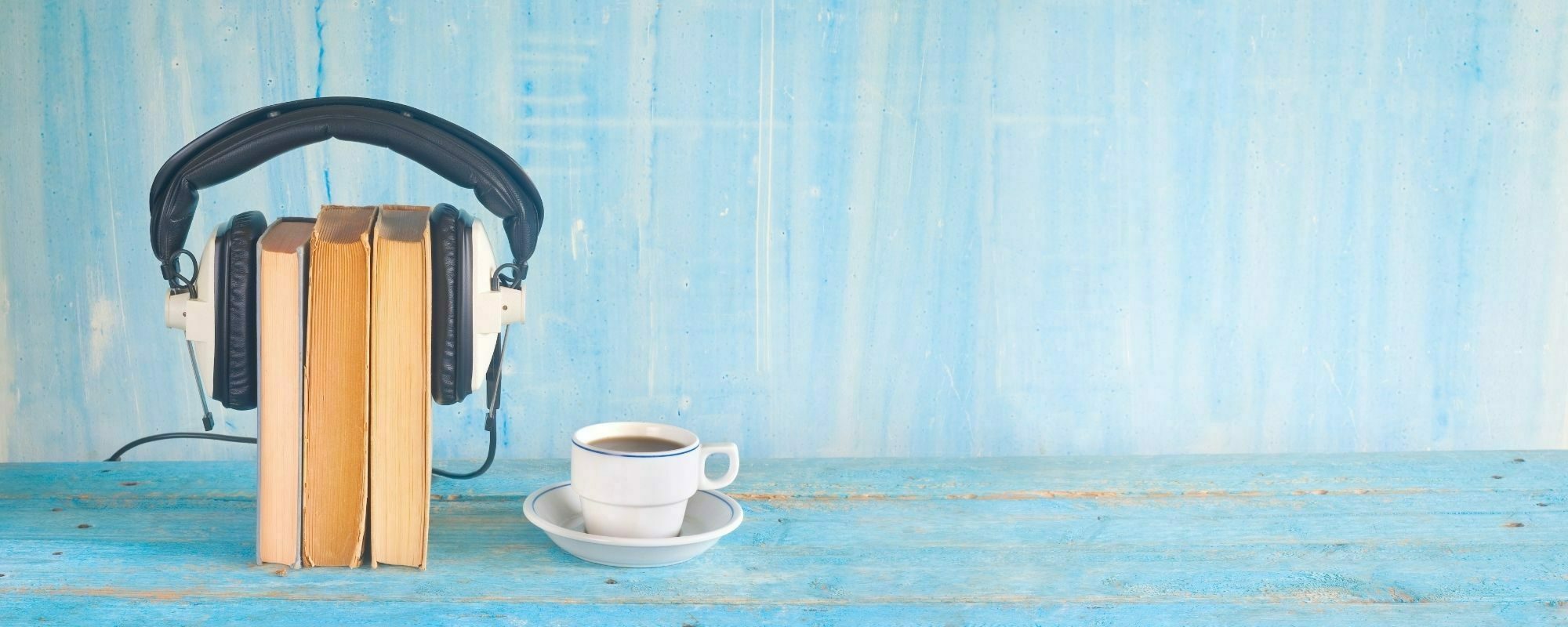
About the Show
The Inside Community Podcast brings folks along for an inside look at all of the beautiful and messy realities of creating and sustaining a community. We provide useful and inspiring content to support people on their quest for resilience, sustainability, and connection.

Meet Your Host
Inside Community Podcast host Rebecca Mesritz is a community builder living in Williams, Oregon. In 2011, Rebecca co-founded the Emerald Village (EVO) in North County San Diego, California. During her ten years with EVO, she supported and led numerous programs and initiatives including implementation and training of the community in Sociocracy, establishment of the Animal Husbandry program, leadership of the Land Circle, hosting numerous internal and external community events, and participation in the Human Relations Circle which holds the relational, spiritual and emotional container for their work.
In June of 2021, with the blessing of EVO, Rebecca and 3 other co-founders relocated to begin a new, mission- driven community and learning center housed on 160 acres of forest and farmland. Rebecca is passionate about communal living and sees intentional community as a tool for both personal and cultural transformation. In addition to her work in this field, she also holds a Master of Fine Arts degree from San Diego State University and creates functional, public, and interactive art in metal, wood, and pretty much any other material she can get her hands on. She is a mother, a wife, an educator, a nurturer of gardens, an epicurean lover of sustainable wholesome food, and a cultivator of compassion and beauty.

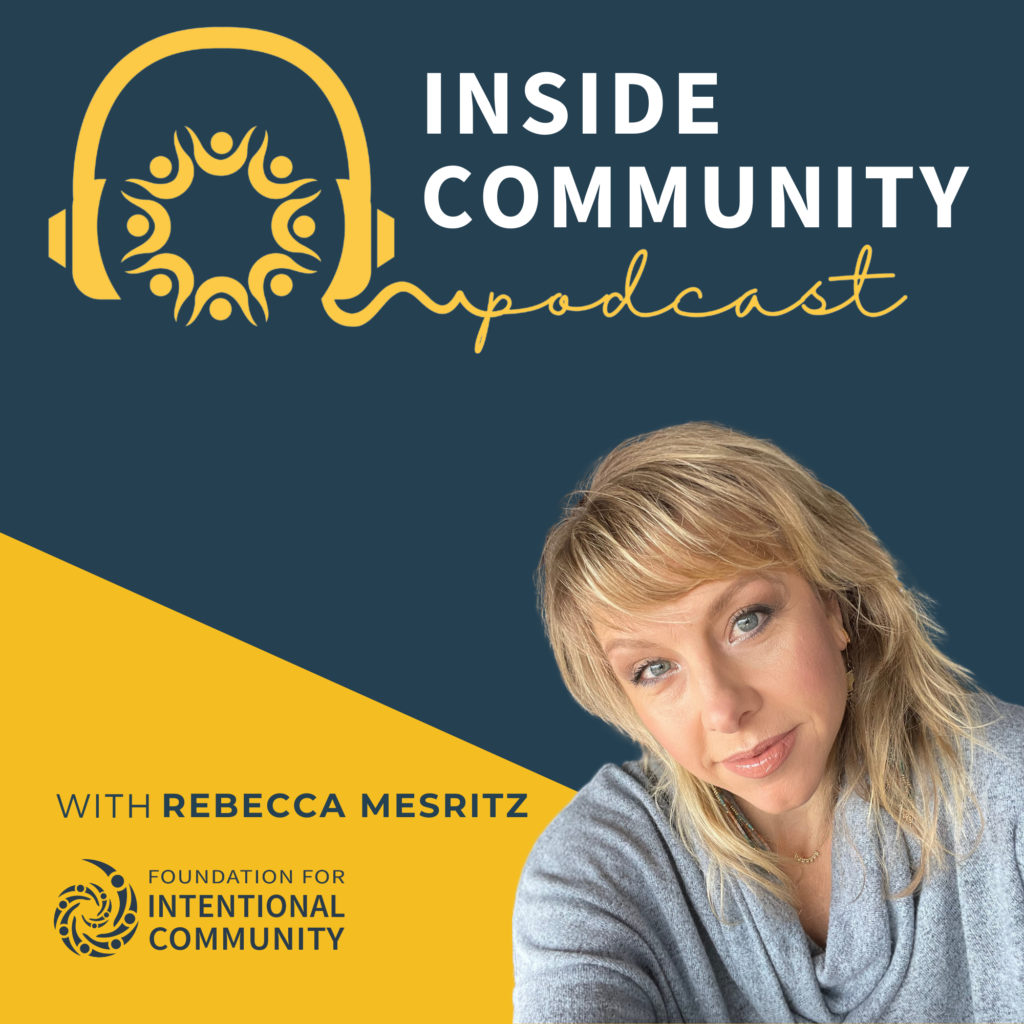
The Inside Community Podcast is sponsored by the Foundation for Intentional Community (FIC). Reach out if you are interested in sponsorship or advertisement opportunities on the podcast.

